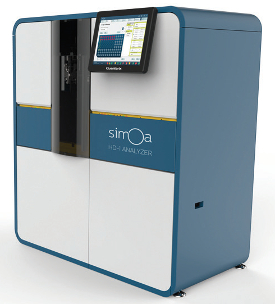Featured Article

Quanterix (Lexington, Mass.) was founded in 2007 with the goal of commercializing a diagnostic platform capable of measuring individual proteins at concentrations 1000 times lower than can be done using the best current immunoassays. The exclusive licensee of a broad intellectual property portfolio initially developed at Tufts University by Dr. David Walt, the company’s Simoa—or Single Molecule Array—platform (Figure 1) enables the detection and quantification of single-molecule biomarkers in matrices such as plasma, serum, cerebrospinal fluid and cell extracts. This capability points to its potential for pharmaceutical companies, clinicians and researchers working in neurology, infectious disease research, cardiology, oncology and other areas.
 Figure 1 – With Simoa, researchers can detect single protein molecules in biological matrices.
Figure 1 – With Simoa, researchers can detect single protein molecules in biological matrices.To begin an assay, antibody-capture agents are attached to the surface of 2.7-μm-diameter paramagnetic beads, each containing upwards of 250,000 attachment sites. Typically, 500,000 beads will be added to a 100-μL sample. At low target concentrations when the number of beads is greater than the number of target molecules in a sample, each bead will capture 0 or 1 target molecules. The fraction of beads that capture a target molecule in a given sample follows the Poisson Distribution. With so many beads in the solution, the bead-to-bead distance is so small that every molecule encounters a bead in less than a minute. At this time scale, diffusion of the target analyte molecules, even large proteins, occurs quickly, and in theory all the molecules should have multiple collisions with multiple beads, dramatically increasing binding.
 Figure 2 – Single molecules are trapped in femtoliter-sized wells on a Simoa Disc, which allows for a “digital” readout of each individual bead to determine if it is bound to the target analyte or not.
Figure 2 – Single molecules are trapped in femtoliter-sized wells on a Simoa Disc, which allows for a “digital” readout of each individual bead to determine if it is bound to the target analyte or not.The beads are washed to remove nonspecifically bound proteins and are incubated with biotinylated detection antibody and then with β-galactosidase-labeled streptavidin. In this manner, each bead that has captured a single protein molecule is labeled with an enzyme. Beads that do not capture a molecule remain label-free. The beads are loaded into arrays of 216,000 femtoliter-sized wells, each of which hold no more than one bead (Figure 2). Beads are added in the presence of substrate, and wells are subsequently sealed with oil and imaged. If a target analyte has been captured (that is, an immune complex has formed), then the substrate will be converted to a fluorescent product by the captured enzyme label. The ratio of the number of wells containing an enzyme-labeled bead to the total number of wells containing a bead corresponds to the analyte concentration in the sample. By acquiring two fluorescent images of the array, it is possible to demonstrate an increase in signal and thus confirm the presence of a true immune complex: beads associated with a single enzyme molecule (an “on” well) can be distinguished from those not associated with an enzyme (an “off” well). The protein concentration in the test sample is determined by counting the number of wells containing both a bead and a fluorescent product relative to the total number of wells containing beads. Concentration is determined by digital ELISA.
Digital measurement detects lower concentrations of proteins than conventional ELISA based on its sensitivity to enzyme labels and the low level of background signal that digitization affords. For antibodies of given affinity, the sensitivity of the immunoassay will be determined by the assay background. High label sensitivity and decreased label concentration help reduce nonspecific binding to the capture surface, resulting in much lower background signal. The detection and quantification of biomarkers that were previously difficult or impossible to measure are enabling applications that address unmet needs in life science research, biopharmaceutical research and development and in vitro diagnostics.
Fewer than 150 proteins having FDA approval are in use today, yet the human proteome contains over 2500 secreted proteins. Most of the “missing” proteins are simply below the detection limit of even what are considered the most sensitive ELISAs. More sensitive measurements will likely result in earlier detection of cancer and infectious diseases and identification of a host of new biomarkers with utility for in vitro and companion diagnostics.
The Simoa process is completely automated: either 96-well plates or tubes containing the sample of interest (e.g., plasma, serum, CSF, cell lysate, urine) are loaded into the sample bay, and assay-specific reagents are loaded into the reagent bay. Once the desired assay is selected, the Simoa performs all mixing, washing, incubation and sample readout, reporting the first result in 30 minutes and subsequent results every 45 seconds thereafter. Results can be viewed and analyzed onboard or exported to commonly used software packages and LIMS.
An open platform and Simoa Homebrew kit allow development of proprietary assays to proteins of interest. Multiplexing options are provided up to 10-plex on a variety of analyte panels. Assays are available for proteins that are important in the study of neurology, oncology, inflammation and cardiac and infectious diseases.
Detection of oncogenic biomarkers at ultralow levels is enabling new options for diagnostics and treatment. Simoa-based biomarker assays can be used to monitor cancer risk, identify early-stage cancers and discriminate between benign and malignant cells. These biomarkers can be used to predict disease outcome and progression-free survival and monitor recurrence. Additionally, the assays can be used to check sensitivity to therapy and aid in treatment decisions.
The measurement of tumor-specific antigens in blood could eventually replace biopsies, but has been limited by sensitivity. Schubert et al. described the feasibility of using a Simoa assay to monitor tumor cell proliferation by detection of a tumor cell-specific antigen in blood.1 These ultralow prostate-specific antigen (PSA) levels in blood could be directly correlated with tumor formation and progression. In another application of the Simoa-based PSA assay, conducted in collaboration with Johns Hopkins University School of Medicine and New York University, Quanterix analyzed serum PSA levels in patients following surgery. PSA levels were measured for all samples, despite being below the limit of detection of existing assays. These concentrations were found to be predictive of prostate cancer recurrence over five years, suggesting that such a measurement could be useful to help inform the most appropriate patient treatment algorithm following prostatectomy and provide peace of mind for individuals at low risk of recurrence.
Researchers at Quanterix have recently developed Simoa-based c-Met and phospho c-Met assays with detection limits in the femtogram/milliliter range. These biomarker assays can be used to monitor c-Met inhibitor development and activation of a variety of key oncogenic pathways and other oncological events like angiogenesis.
Kevin Hrusovsky, CEO of Quanterix, was eager to discuss some of the research that came out of the recent Quanterix-sponsored Powering Precision Health Summit, which Hrusovsky founded. There was “…breakthrough science, [for example] describing the ability to see breast cancer using a non-invasive blood test, with significantly more accuracy than [that provided by a] mammogram. Fifteen protein biomarkers were presented, eight of which were separated out, and we were able to achieve over 95% accuracy, and detected some of the more aggressive breast cancers that mammograms don’t always detect. Being able to see disease, [at this] very early stage, long before symptoms present, can be gamechanging in terms of diagnosis and treatment.”
Neurological research shows that it is possible to detect biomarkers associated with chronic traumatic encephalopathy in blood and spinal fluid. At the summit, researchers from the NIH reported that, with Simoa, they could see evidence of concussion in blood samples, and are conducting research on athletes and soldiers. Early detection of these biomarkers may lead to the ability to observe athletes so as to implement procedures for early intervention. Pharmaceutical companies are using Simoa to monitor the benefits of prospective drug therapies for diseases such as Alzheimer’s. Hrusovsky anticipates a future in which “…diseases can be detected at a point when they are very treatable and curable, before symptoms are manifest.”
The company also hosts the Simoa Accelerator Lab, which is dedicated to custom assay and clinical sample development, outsourced testing and a range of related services. Interested parties can work on custom assays, transforming commercially available or proprietary reagents into fully validated Simoa assays. Feasibility testing and prototype development protocols utilizing proprietary reagents in combination with the Quanterix Homebrew assay development kit can be used to rapidly prototype Simoa assays. A comprehensive list of publications and more detailed information can be found at http://www.quanterix.com.
Reference
- http://www.quanterix.com/resources/publicationsjournals/ ultra-sensitive-protein-detection-single-molecule-arrays-towards